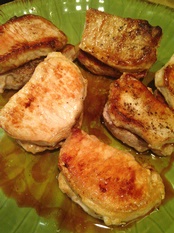WINE WITH…Pork Chops with Anchoiade
There are certain times when nothing says “summer” quite as poignantly as anchovies. Perhaps this emotional taste-connection to tiny, salty, oily fish is triggered by memories of meals in southern France, where sauces based on anchovies can play a starring role in local dining. Sauce Collioure, for one, originally native to the Roussillon, is a variation on aioli but with the addition of anchovies (it’s particularly delicious spooned over poached or grilled fish). In Nice, anchovies are mashed into a paste with olive oil and used to dress Salade Nicoise (authentic salade Niçoise, by the way, consists of quartered tomatoes, bell peppers, black olives, and sometimes hard-boiled eggs and/or canned tuna, but never lettuce. And it is pronounced nee-swahz, not nee-swah). One of the tastiest and most versatile anchovy sauces is anchoide, an ancient traditional multipurpose mixture that generally consists of nothing more than anchovies, olive oil and garlic.
most versatile anchovy sauces is anchoide, an ancient traditional multipurpose mixture that generally consists of nothing more than anchovies, olive oil and garlic.
In places like Corsica and Nice, anchoiade is often spread on slices of bread soaked in olive oil, showered with breadcrumbs, drizzled with more oil, and slipped into a hot oven until nicely browned. Anchoiade also makes a great sauce for pasta, and it can brighten up certain meat preparations in a surprisingly delicious way–as we discovered with this recipe for pork chop and anchoiade “sandwiches.”
Pork Chops with Anchoiade
Makes 4 servings
The Anchoiade
One 2-ounce can anchovies
2 cloves garlic, minced
1 teaspoon red or white wine vinegar
1/2 cup olive oil
Freshly ground pepper
The Pork Chops
Salt and pepper
2 tablespoons butter
2 tablespoons olive oil
8 boneless but thin pork chops, each about ½ inch thick
To make the anchoiade, use a mortar and pestle, a mini food processor or simply the back of a spoon and a bowl. Chop the anchovies coarsely along with a little of their oil, then add the garlic and mash together into a fairly smooth paste. Stir in the vinegar, then incorporate a couple of spoonsful of olive oil into the mix. Add the remaining oil, working it in as much as possible (the mixture does not have to be completely emulsified). Add a few grinds of pepper and reserve the anchoiade until ready to serve.
To make the pork, salt and pepper the chops on both sides, preferably 30 minutes or so before cooking. Heat a large, sturdy skillet and, when hot, add 1 tablespoon each of butter and olive oil. Add half of the chops and, over high heat (lowering the heat if the meat begins to burn), sear the meat quickly on both sides, about 4 minutes total; the chops should be nice and brown but not dry and overcooked. Remove the chops from the pan, add the remaining butter and oil, and cook the rest of the chops the same way.
Arrange half the chops on a serving platter. Reserving about 3 tablespoons of the anchoiade for garnish, divide the rest of the sauce over the chops on the platter. Top each one with the remaining chops, and drizzle the remaining sauce over each “sandwich.”
We found that red and white wines worked equally well with this dish, but that no matter the color, the best matches included wines that had just a hint of sweetness to counter the salty piquancy of the anchoiade. This meant that dry, delicate wines did not fare well. Nor did heavy tannic ones. When choosing a wine to accompany pork and anchoiade, look for something neither too powerful nor too slight. And don’t be afraid of a little sugar.
|
Selection
|
Approx. Price |
Comments |
|
Badenhorst Family Wines, Swartland (South Africa) Chenin Blanc “Secateurs” 2013 (Imported by Broadbent Selections)
|
$15 |
A bright but juicy white, with just enough body to hold up to the dish, this wine tastes of ripe pears and golden apples. It loses a bit of complexity in the pairing, but retains plenty of succulent, juicy flavor. |
|
Cambria, Santa Maria Valley (California) Pinot Noir “Julia’s Vineyard” 2012
|
$25 |
This wine may seem overly sweet on its own, but it was a definite winner with the dish. Its fresh cherry flavors turned luscious, and its finish made us eager for another sip. |
|
Neil Ellis, Elgin (South Africa) Chardonnay 2011 (Imported by Vineyard Brands)
|
$28 |
A buttery, tropical-scented Chardonnay, with echoes of pineapples and mangoes along with bright citrus, this wine offered just the right sort of weight to pair nicely with the pork anchoiade. |
|
Herman Moser, Kremstal (Austria) Grüner Veltliner “Per Due” 2012
(Imported by Boutique Wine Collection)
|
$17 |
We were surprised at how well this wine performed, as we feared it might be too light. But it’s crisp autumnal fruit, enhanced by a hint of pepper, proved to make a superior match. The wine provided an especially good counterpoint to the salty anchoiade. |
|
Maison Nicolas Perrin, Vin de France (France) Syrah 2012(Imported by Vineyard Brands)
|
$17 |
Full of sweet red fruit flavor, with a peppery undertone, this wine offered many of the same advantages as the Grüner Veltliner–succulent fruit and spicy depth. Which was better? Neither. The choice depends on your mood and color preference, not on either of the wines themselves. |
